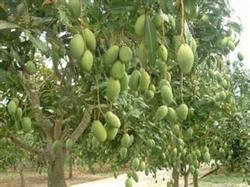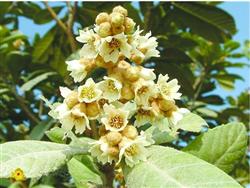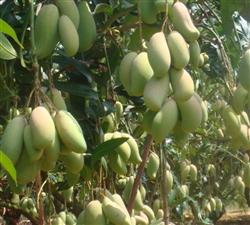Field management of pollution-free mango

(1) soil management: combined with the application of base fertilizer, a ditch was dug under the dripping line on both sides of the canopy. The size of the conventional ditch was 100 cm × 50 cm × 40 cm, and green manure, mature organic fertilizer and phosphate fertilizer were added. It is suggested that dwarf legume green manure, forage grass, other nectar plants or interrow grass should be planted in mango orchard, but the intercrop should be more than 1 meter away from the base of mango tree, and the selection of grass species should be short-stalked or creeping, without common diseases and insect pests with mango, and the growth period is short, such as thistle. It is recommended that mango root circle or planting belt should be covered with annual mulch. (2) weeding: artificial, mechanical or microbial herbicides are used to control root zone weeds. Mechanical, electrical, microbial herbicides or chemical herbicides recommended in this standard are recommended for interrow weeds control. (3) Water management: in the period of mango autumn shoot emergence, flower bud morphological differentiation and fruit development, the soil should be irrigated in time in case of drought. It is recommended to irrigate every 15 to 20 days. (4) fertilization: the types of fertilizers recommended are as follows, nitrate nitrogen fertilizer should not be used. The recommended fertilizers for pollution-free food mango production are as follows. Commercial fertilizers: inorganic fertilizers (nitrogen fertilizer): urea, aluminum chloride. Inorganic fertilizer (phosphate fertilizer): calcium superphosphate, calcium magnesium phosphate fertilizer, phosphate rock powder. Inorganic fertilizer (potash fertilizer): potassium chloride, potassium sulfate. Inorganic fertilizer (calcium fertilizer): quicklime, limestone, dolomite powder. Inorganic fertilizer (magnesium fertilizer): calcium magnesium phosphate fertilizer. Inorganic fertilizer (compound fertilizer): binary and ternary compound fertilizer. Foliar fertilizer (growth assistance): Qingfeng, Yuncaisu, Wandefu, Lvfengbao, Aiduo harvest, Dam bumper harvest, Shield, Yunda, 2116, Opal, Gao Meishi, Huimanfeng and so on. Foliar fertilizer (trace elements): fertilizer containing trace elements such as copper, iron, manganese, zinc, boron, molybdenum and potassium dihydrogen phosphate, urea, potassium chloride, etc. Other fertilizers: sea fertilizer: fish dregs without preservatives, shrimp dregs, shellfish scale, etc. Animal fertilizer: preservative-free cattle and sheep hair waste, bone meal, livestock processing waste, etc. Foliar fertilizer can be applied 2-3 times in autumn shoot turning green stage, flower bud stage and young fruit development stage, with an interval of 7-10 days. The types of foliar fertilizer are as described above.
- Prev

Manage the loquat tree after Xiehua in early spring
First, apply stable fruit fertilizer. When the young fruit of loquat appeared after flowering, stable fruit fertilizer was applied, mainly instant nitrogen, phosphorus and potassium complete fertilizer. For fruit trees more than five years old, 1.5 kilograms of nitrogen, phosphorus and potassium compound fertilizer was applied to each tree, or 40 kilograms of mature human and animal manure water was retted. Second, prevention and control of diseases and pests. When the young fruit appears after the loquat blossoms,.
- Next

How to fertilize mango fruit trees
Fertilization of mango fruit trees should be based on the principle of reasonably adjusting the contradiction between vegetative growth and reproductive growth. It is necessary not only to promote flowering and fruiting in the current year and to control the vigorous growth of summer shoots, but also to promote the emergence and growth of autumn shoots, so as to lay a good foundation for a bumper harvest in the second year. The type of fertilization is still dominated by nitrogen, phosphorus and potassium fertilizer, especially.
Related
- Moge, come on! The staff of the peasant association in the producing area of cantaloupe were frightened when the crowd gathered.
- Causes and Solutions of low Fruit setting rate of Apple
- Symptoms and control measures of passion fruit virus disease
- Fruit growing lesson: how do apple orchards keep high yields?
- Can you build orchards in the mountains? What are the pros and cons?
- How to manage the coloring period of Crisson grape?
- This paper introduces the processing technology of two kinds of fig products.
- How much is a month for retired teachers in rural areas by 2020?
- How can strawberry planting increase sugar content? We should pay attention to management in many aspects.
- What are the cultivation techniques on how to improve the yield of golden fruit?

